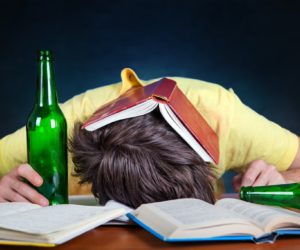College Drug Use Statistics

Find out what the latest college drug use statistics reveal about your student’s safety
If you have a college-age student, finding out what the latest college drug use statistics reveal is a necessity. If you take the literature that college campuses supply students and parents at face value, you might believe that higher learning institutions have all but eliminated the problems of drug and alcohol use on campus. The reality that the latest college drug use statistics reveal is a bit different. Figures from reputable sources including the, 2015 edition of the National Monitoring the Future drug survey sponsored by The National Institute on Drug Abuse, show that while drug use by college students is down in certain key categories, abuse of drugs and alcohol remains an area of concern on campus.
Illicit drug use in college students
The statistics on incidence of illicit drug use among college students show the following results:
- Illicit drugs – 41% of college students used illicit drugs last year. The prevalence of using illicit drugs other than marijuana was 19%.
- Marijuana – Overall use of marijuana by college students is on the rise, but daily use declined. 38% of college students reported using marijuana in the past year, up from 30% in 2006 but just 4.6% of college students using marijuana every day, down from 5.9% in 2014.
- Cocaine – 4.3% of college students reported using cocaine last year. While this figure is slightly lowered from the 4.4% in 2014, it still is up from the all-time low of 2.7% in 2013.
Prescription drug abuse in college students
College drug use statistics show he abuse of prescription drugs is a widespread problem on college campuses across the country. Many students who were prescribed Adderall or other medications for ADHD, end up giving or selling their drugs to fellow students who want to improve their school performance.
- Amphetamines – Much of the drug abuse that occurs in college involves the use of the drugs college students use to stay awake and alert, such as Adderall and other stimulants. 9.7% of college students used any type of amphetamines last year; 10.7 % used Adderall, and 2% used Ritalin.
- Narcotics – Use of narcotics other than heroin fell last year, with 3.3% of students using narcotics down from the all-time high of 8.8% in 2005. 1.5% of students used OxyContin and 1.6% used Vicodin
- Tranquilizers – 4.3% of college students used tranquilizers in the past year
Alcohol abuse in college students
The latest insights on alcohol abuse in college students given by, The National Institute on Alcohol Abuse and Alcoholism, reveal some disturbing facts. According to information from the 2015 National Survey on Drug Use and Health (NSDUH), college students between the ages of 18 and 22 abuse alcohol at higher rates than other persons of the same age. The study showed that these increased rates occurred in the prevalence of drinking, binge drinking, and heavy drinking.
Here are the study’s 2015 statistics on the prevalence of college student alcohol abuse, along with statistics on the consequences suffered as a result:
- 79% of college students used alcohol in the past year
- 58% of college students drank alcohol in the past month compared to 48% of other young adults
- In the past month, approximately 38% of college students engaged in binge drinking (5 or more drinks) compared to 33% of non-students
- Just under 13% of college students reported heavy or extreme binge drinking (10 or more drinks) in the past month compared to less than 9% of other young adults
- Researchers estimate that 696,000 college students between the ages of 18 and 24 are assaulted by a student who was drinking
- 97,000 college students between the ages of 18 and 24 report experiencing alcohol-related sexual assault or date rape. Alcohol-related sexual assaults often go unreported, so the actual figures may be significantly higher.
If you or a loved one needs help with abuse and/or treatment, please call the WhiteSands Treatment at (877) 855-3470. Our addiction specialists can assess your recovery needs and help you get the addiction treatment that provides the best chance for your long-term recovery.
